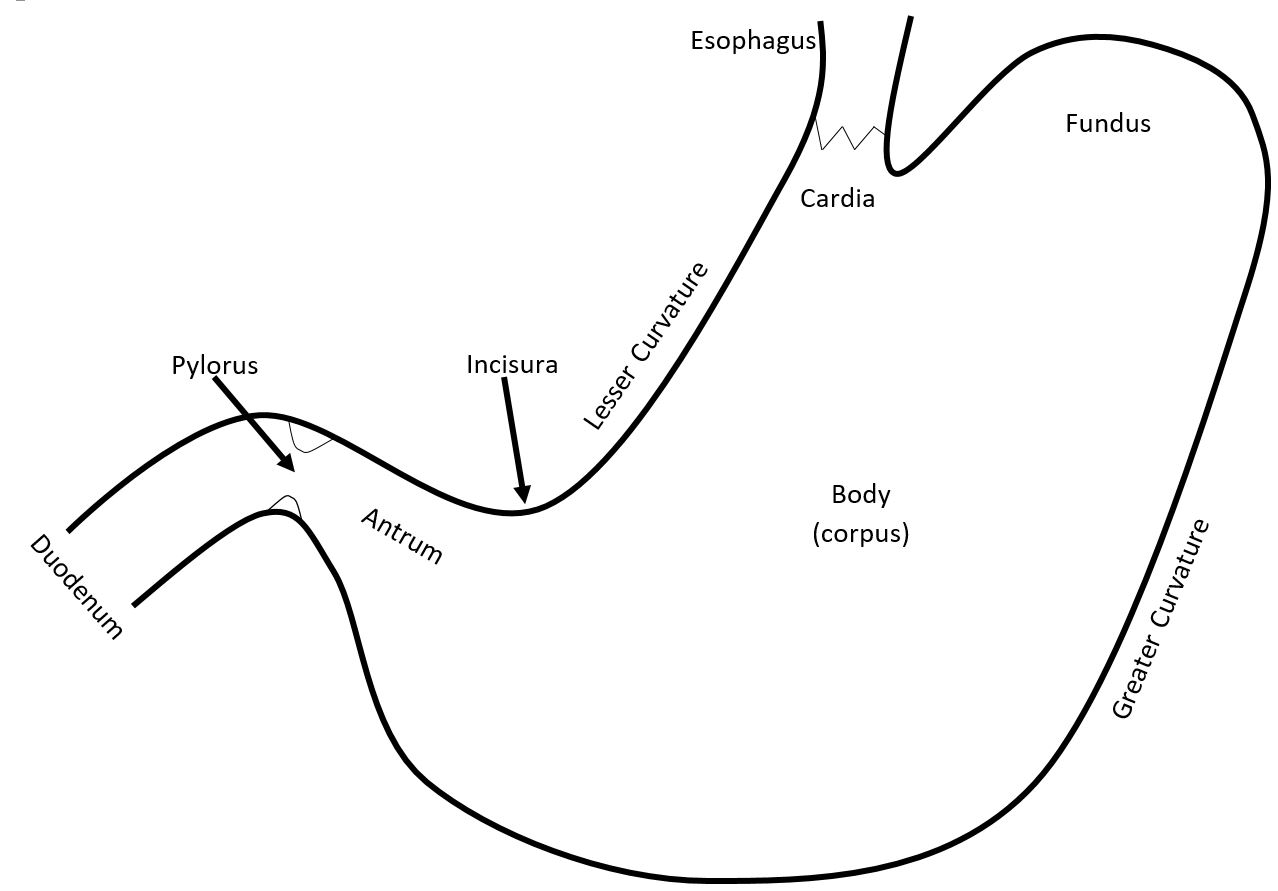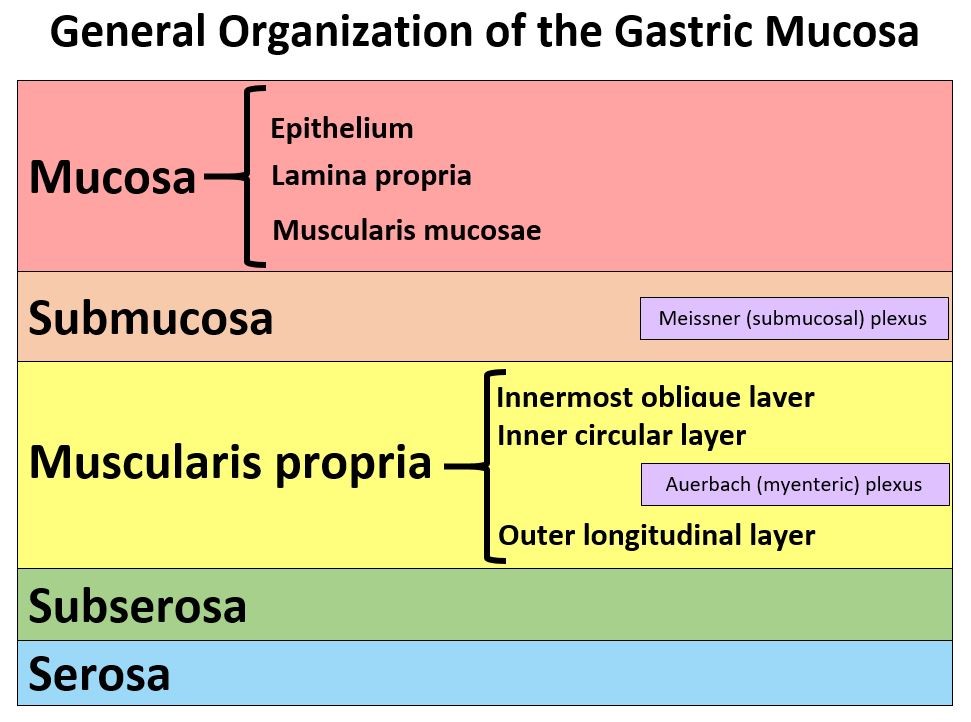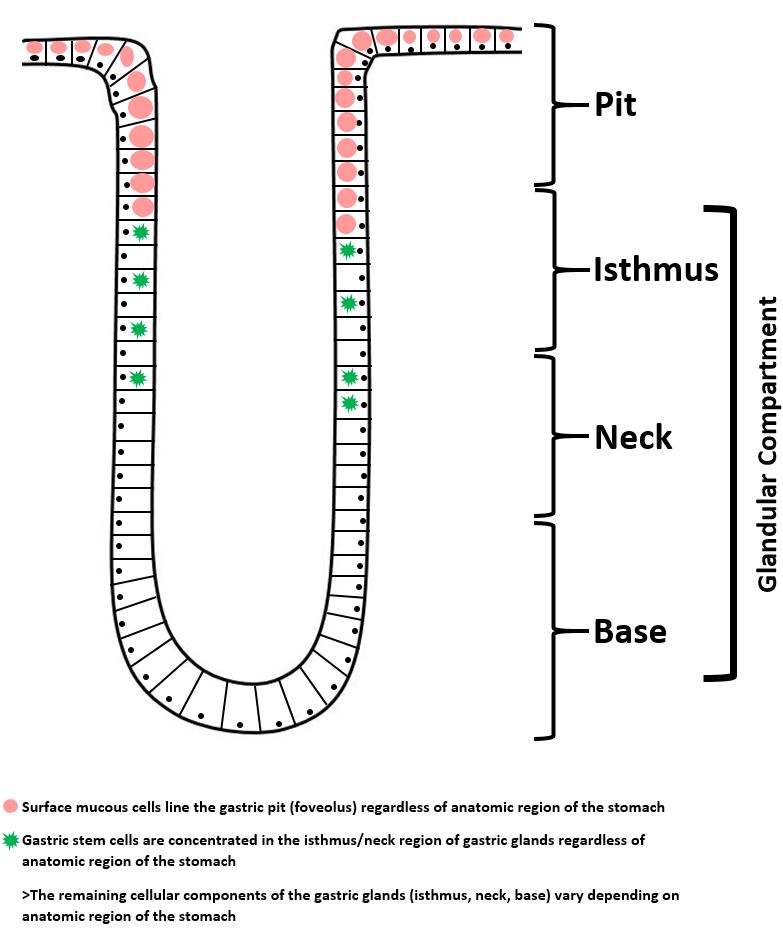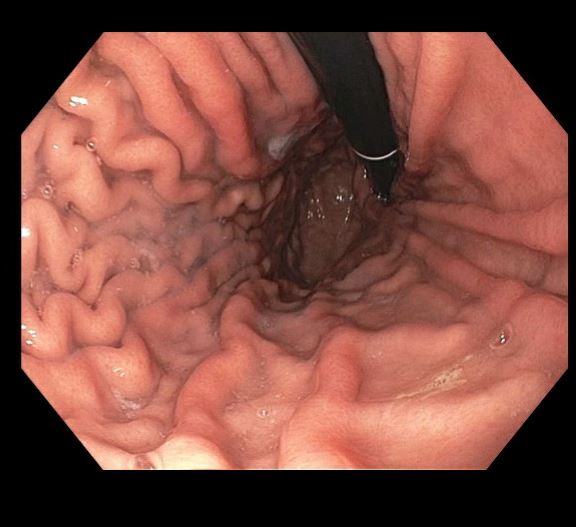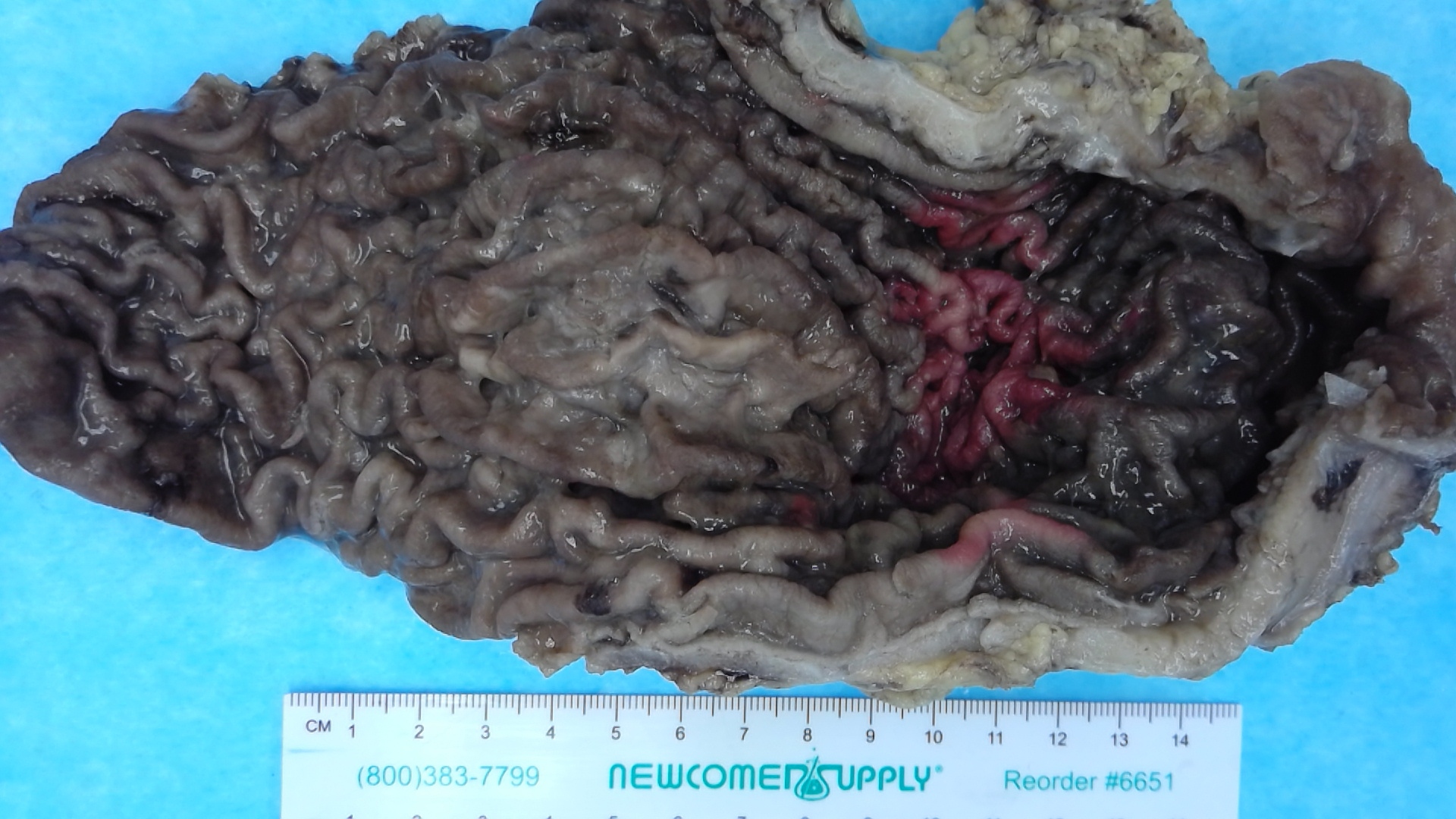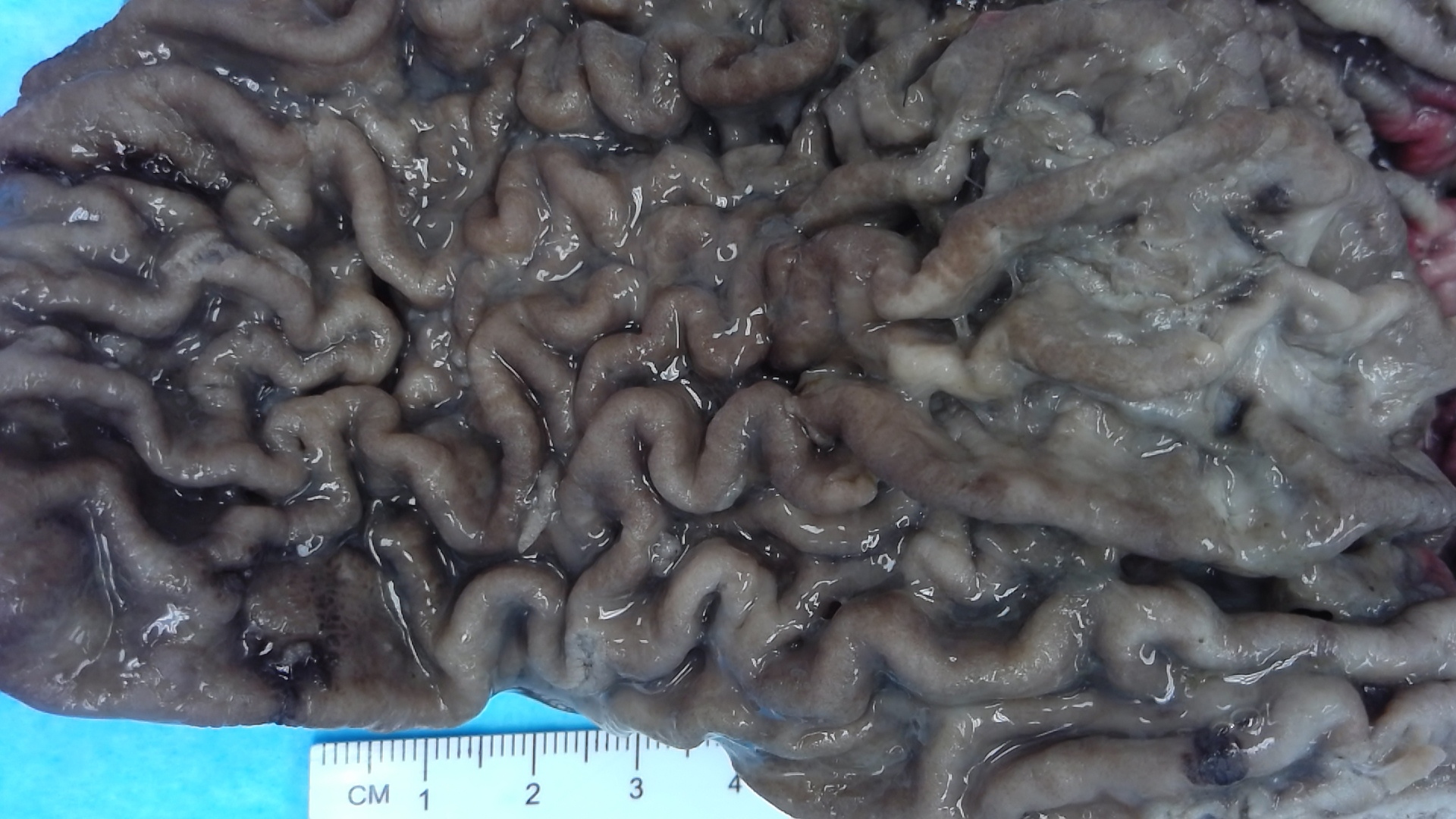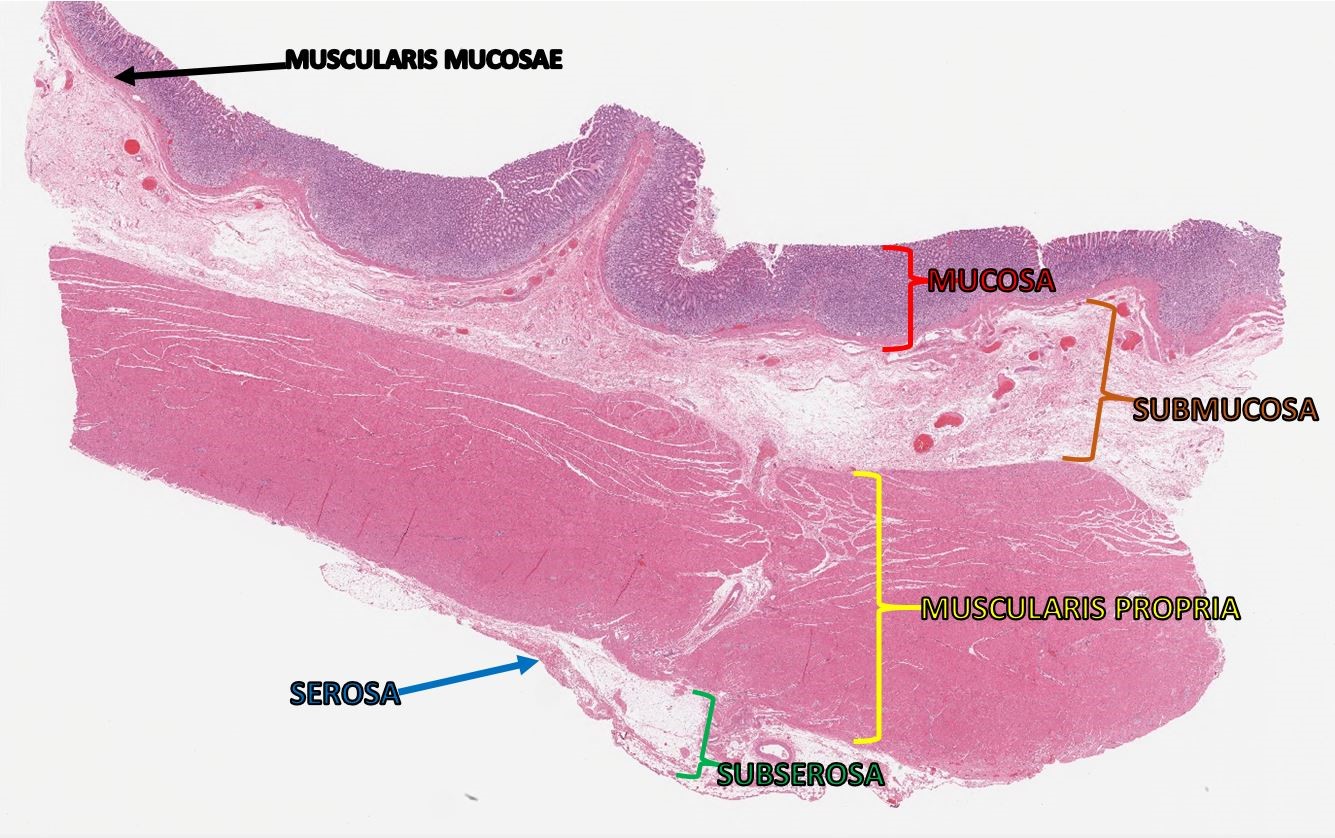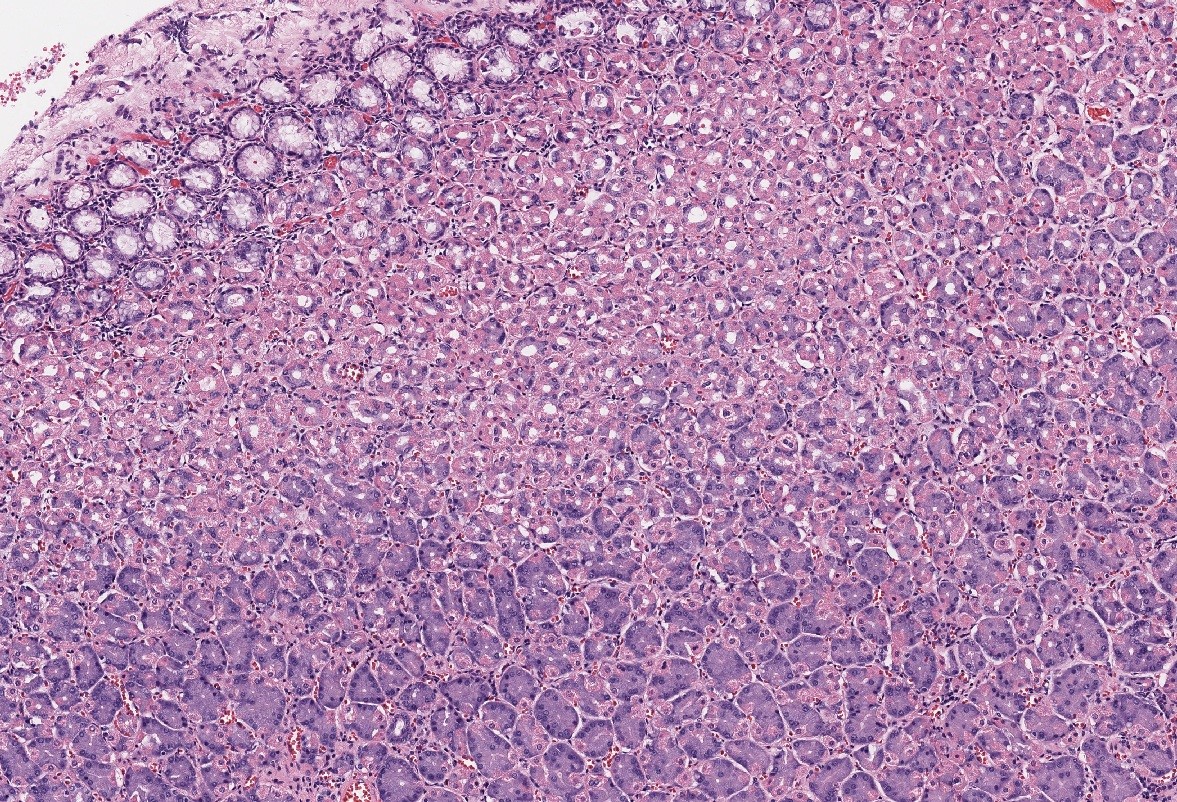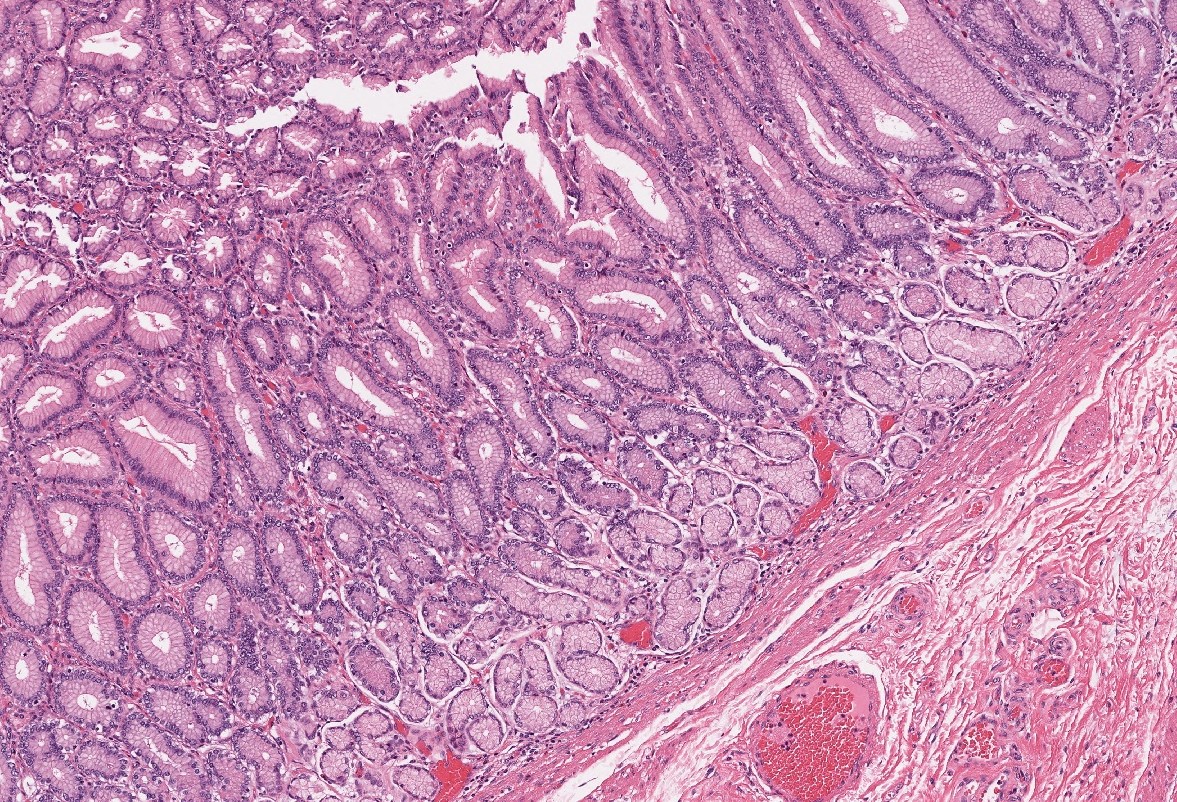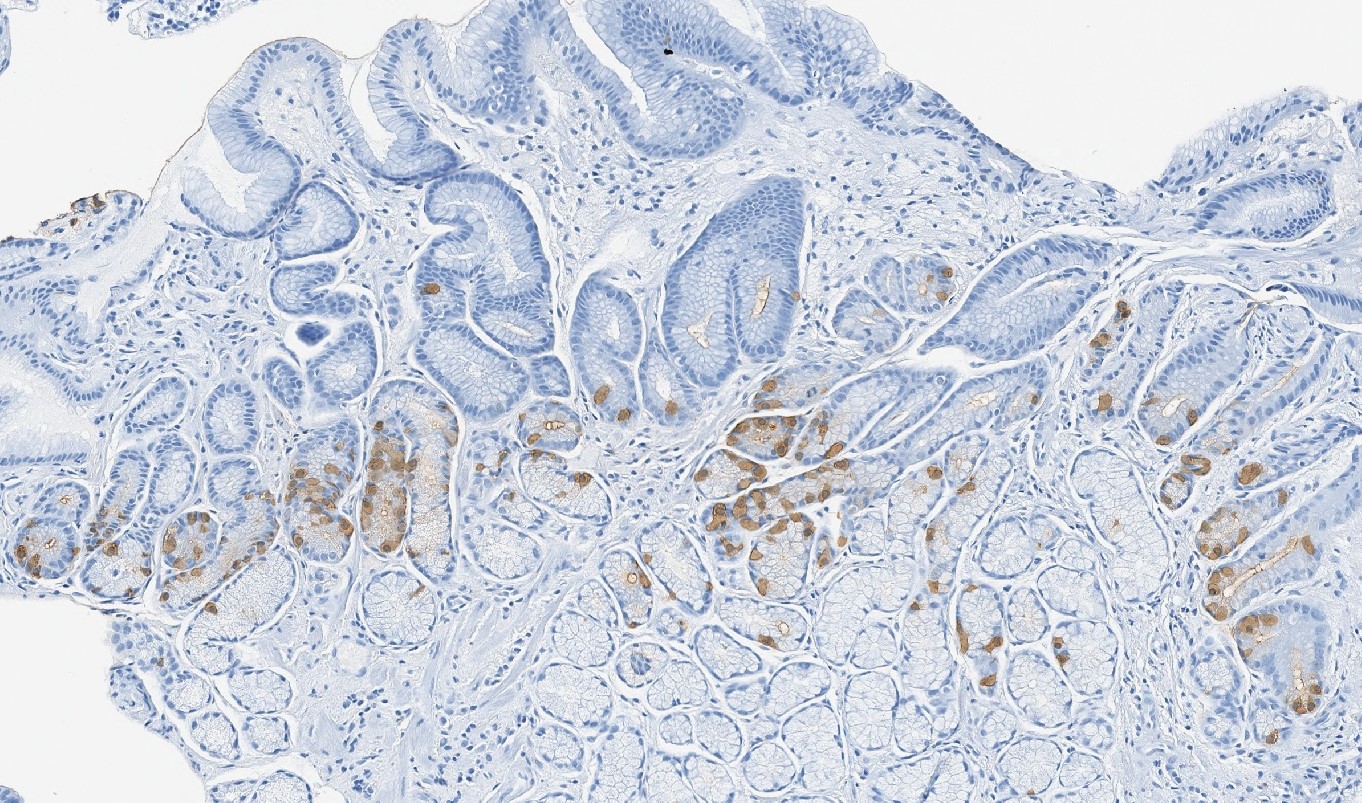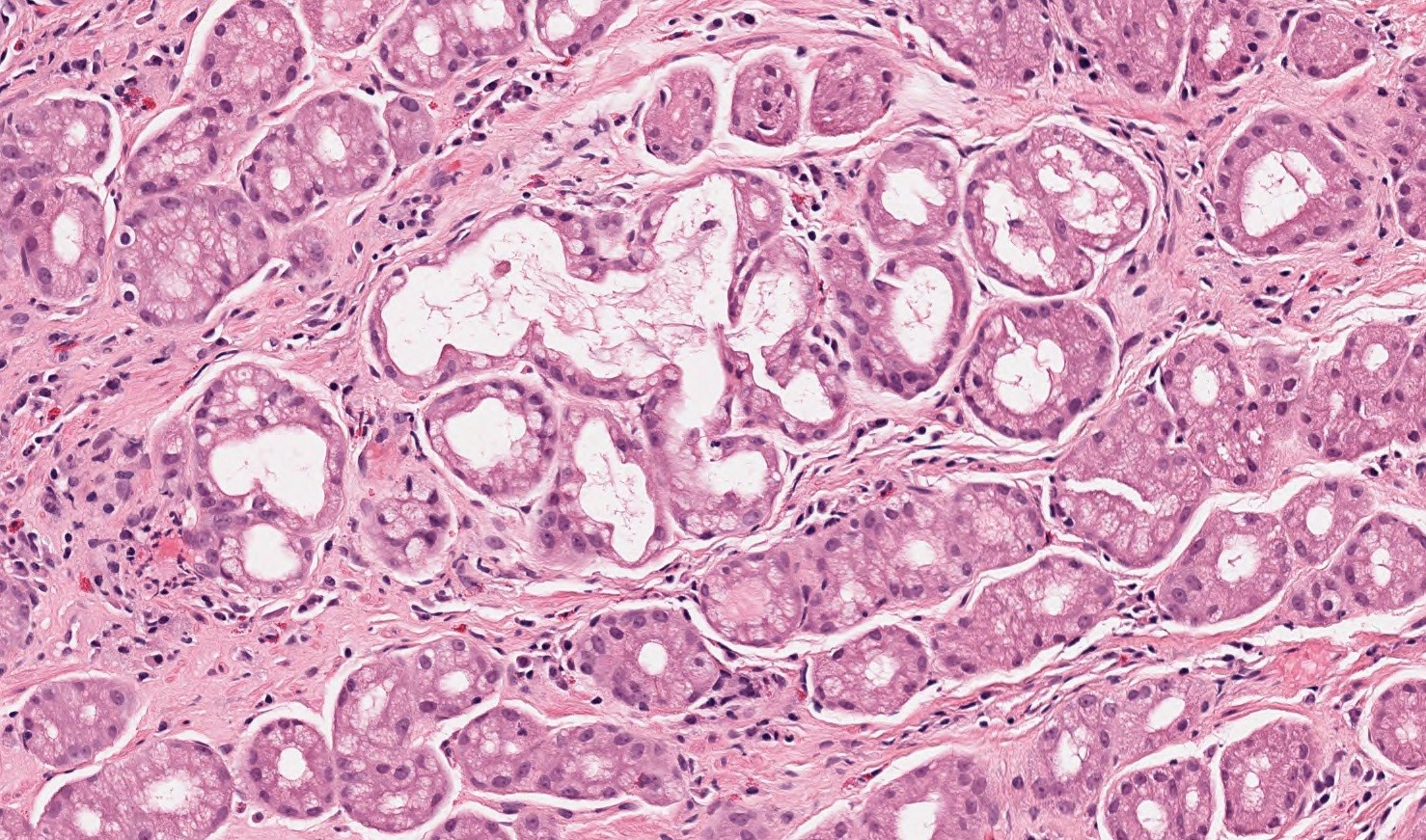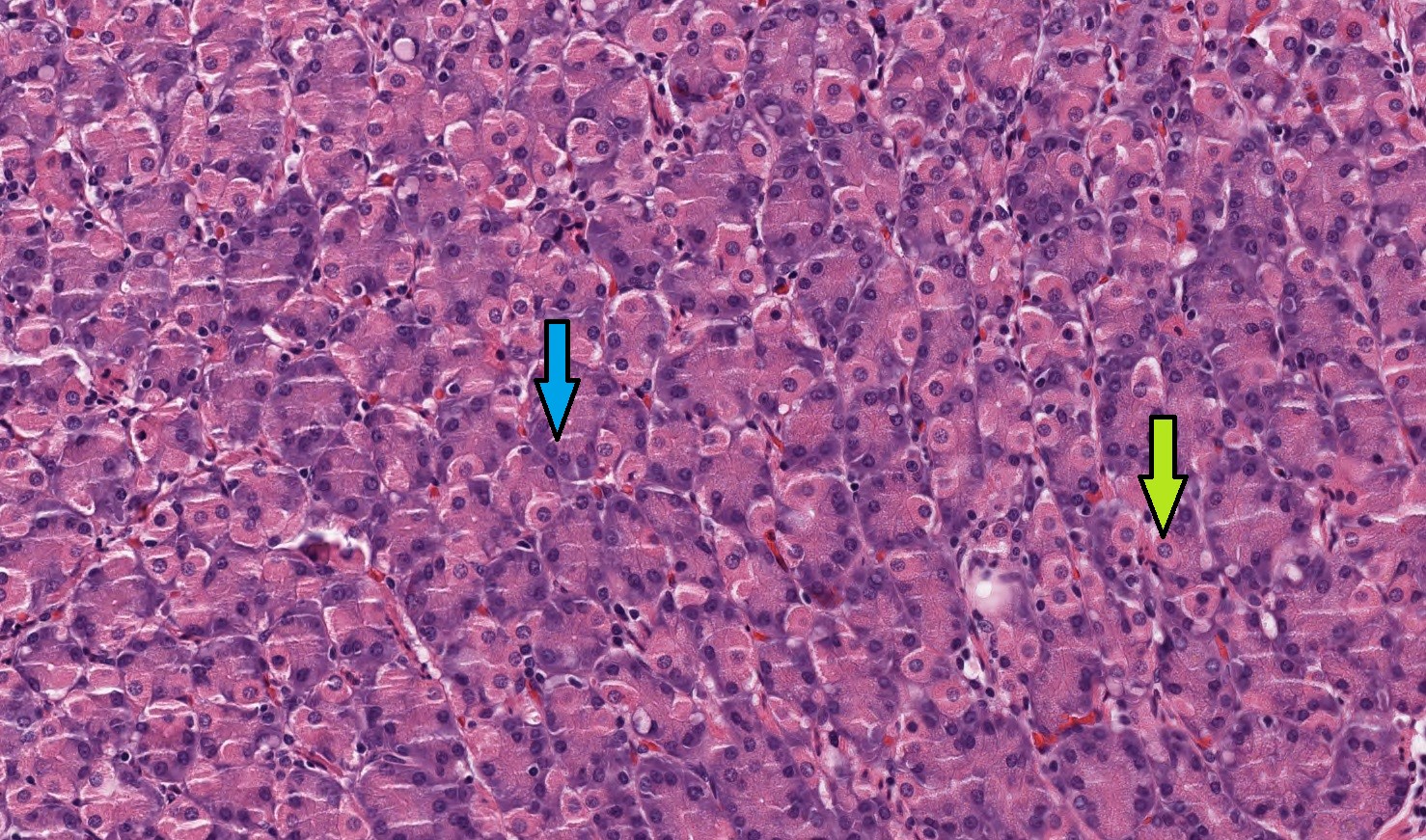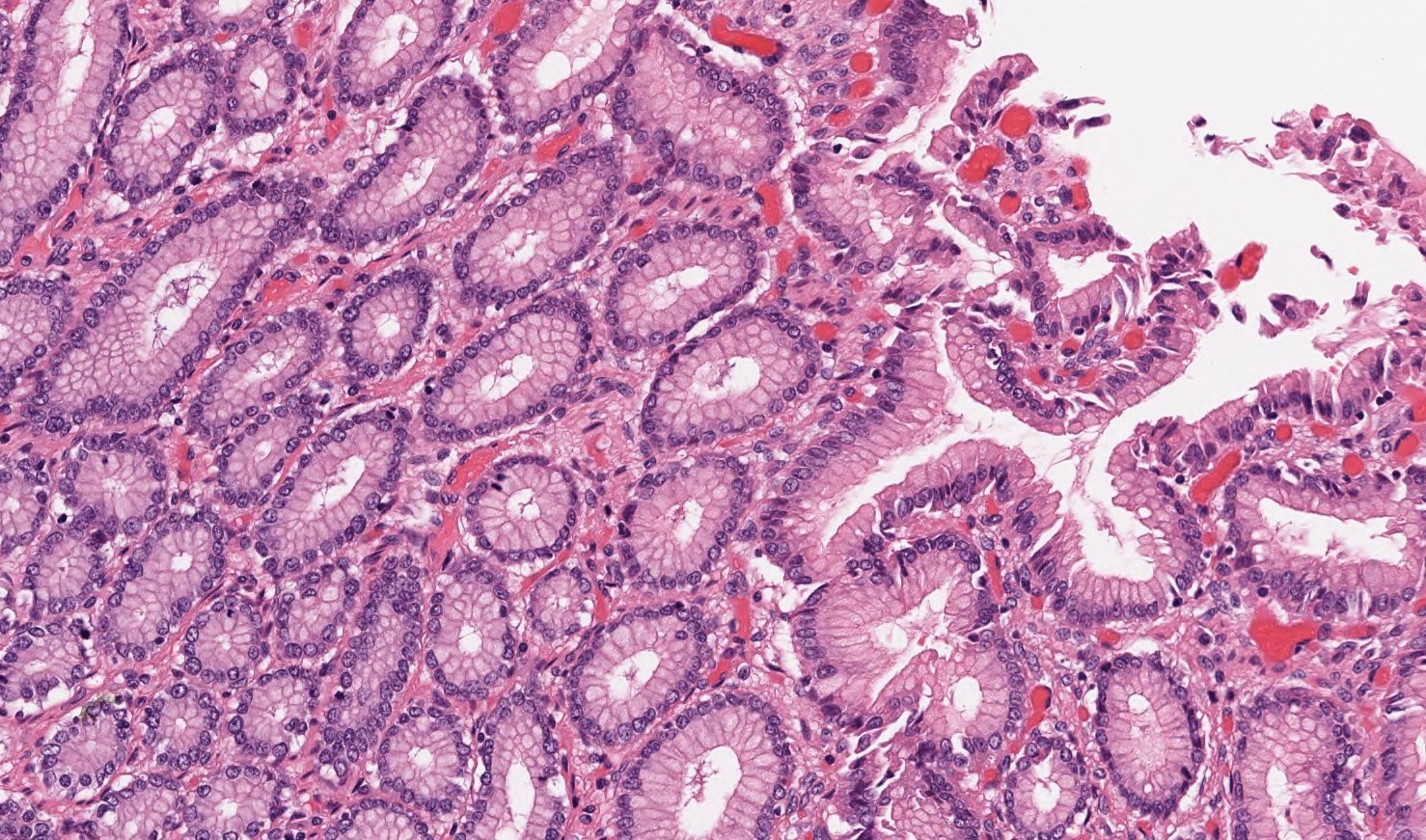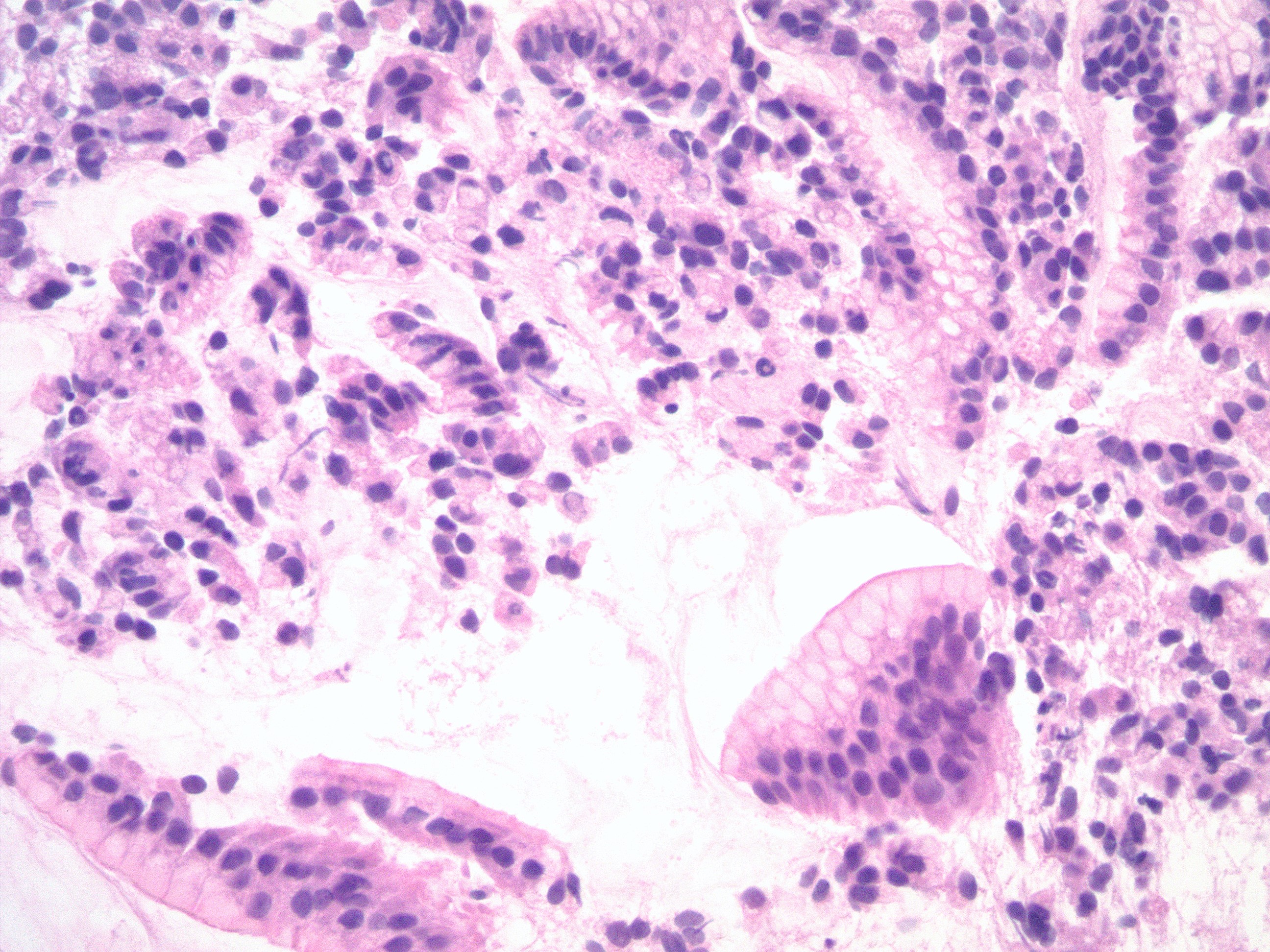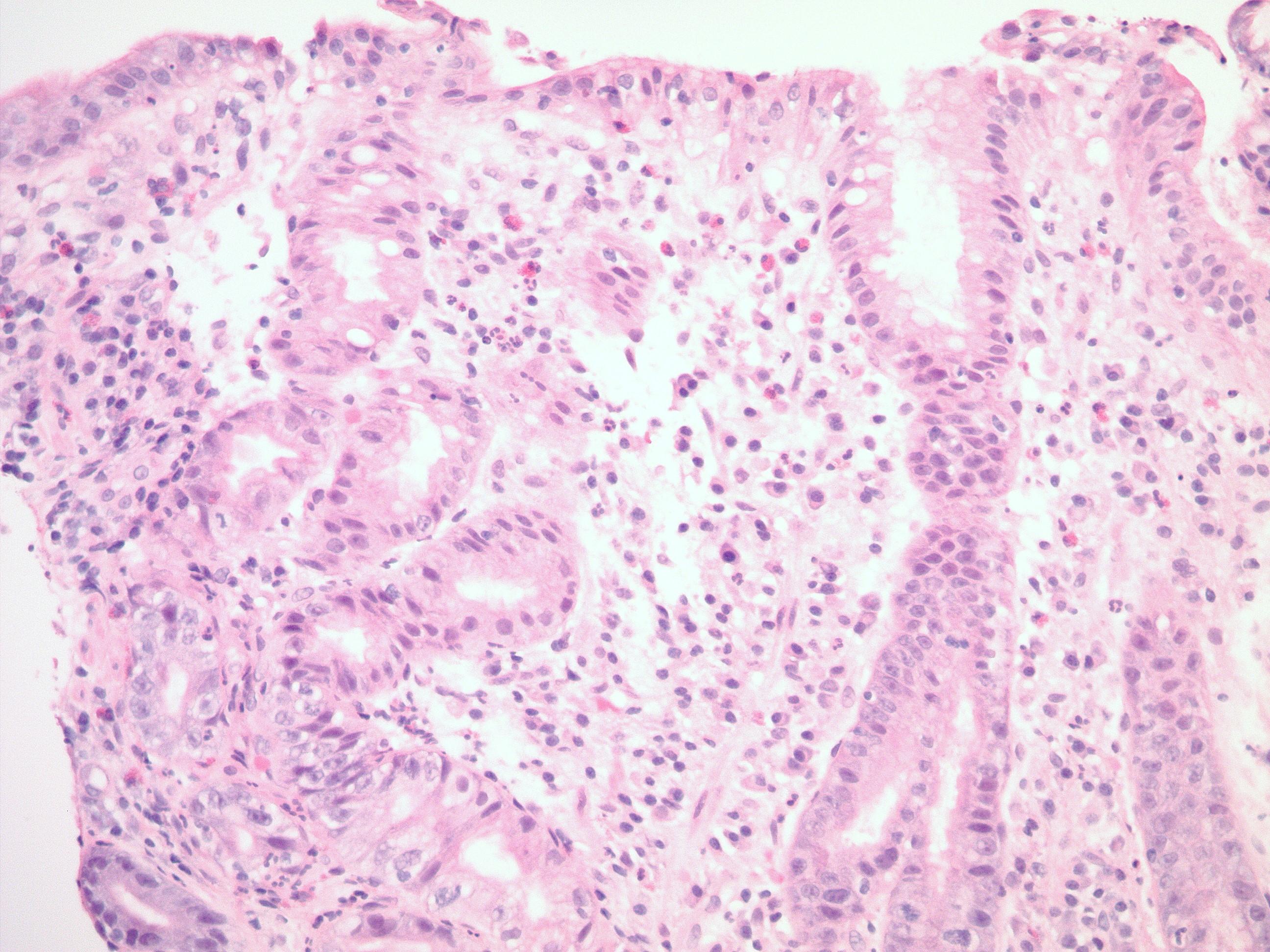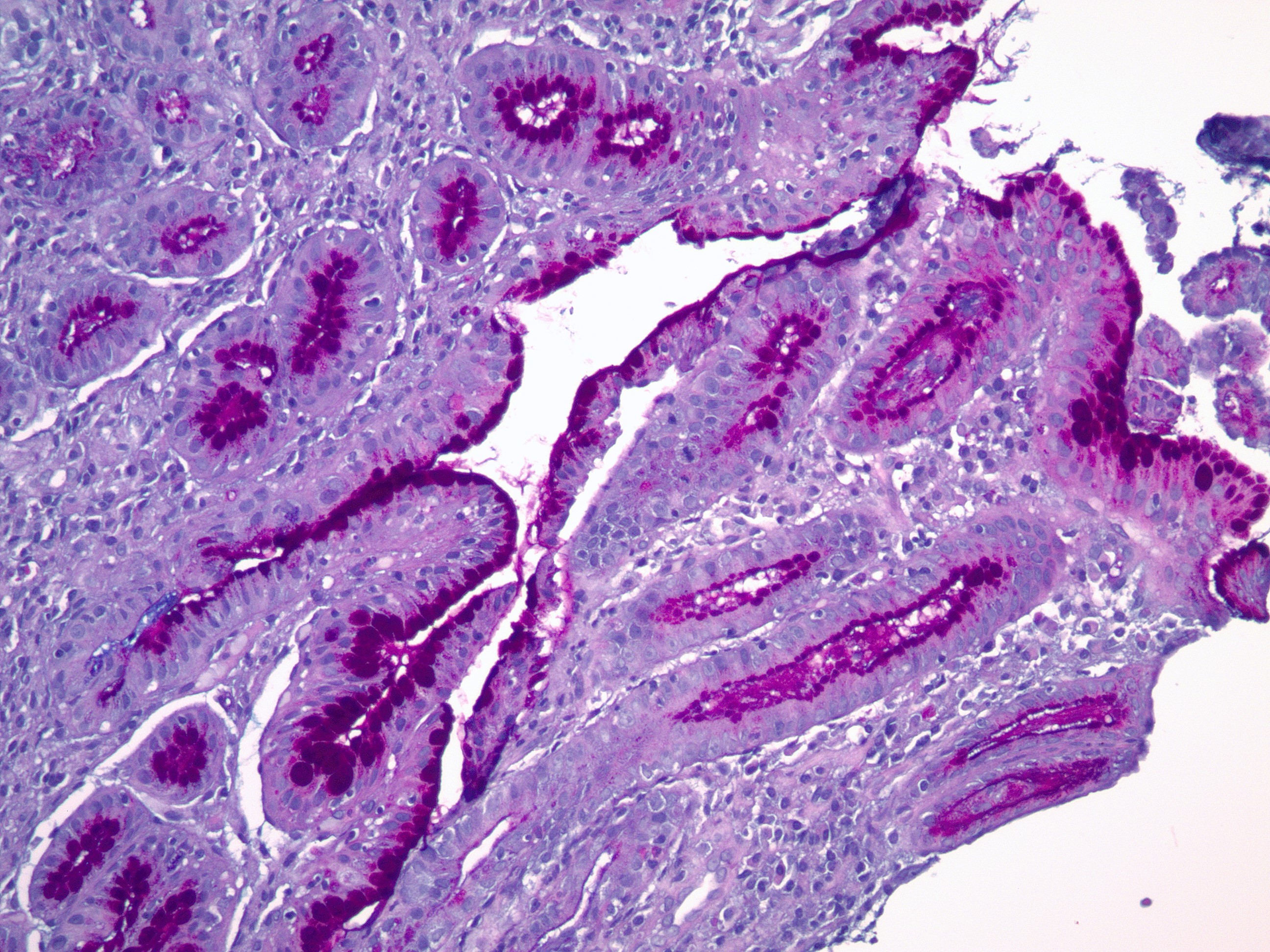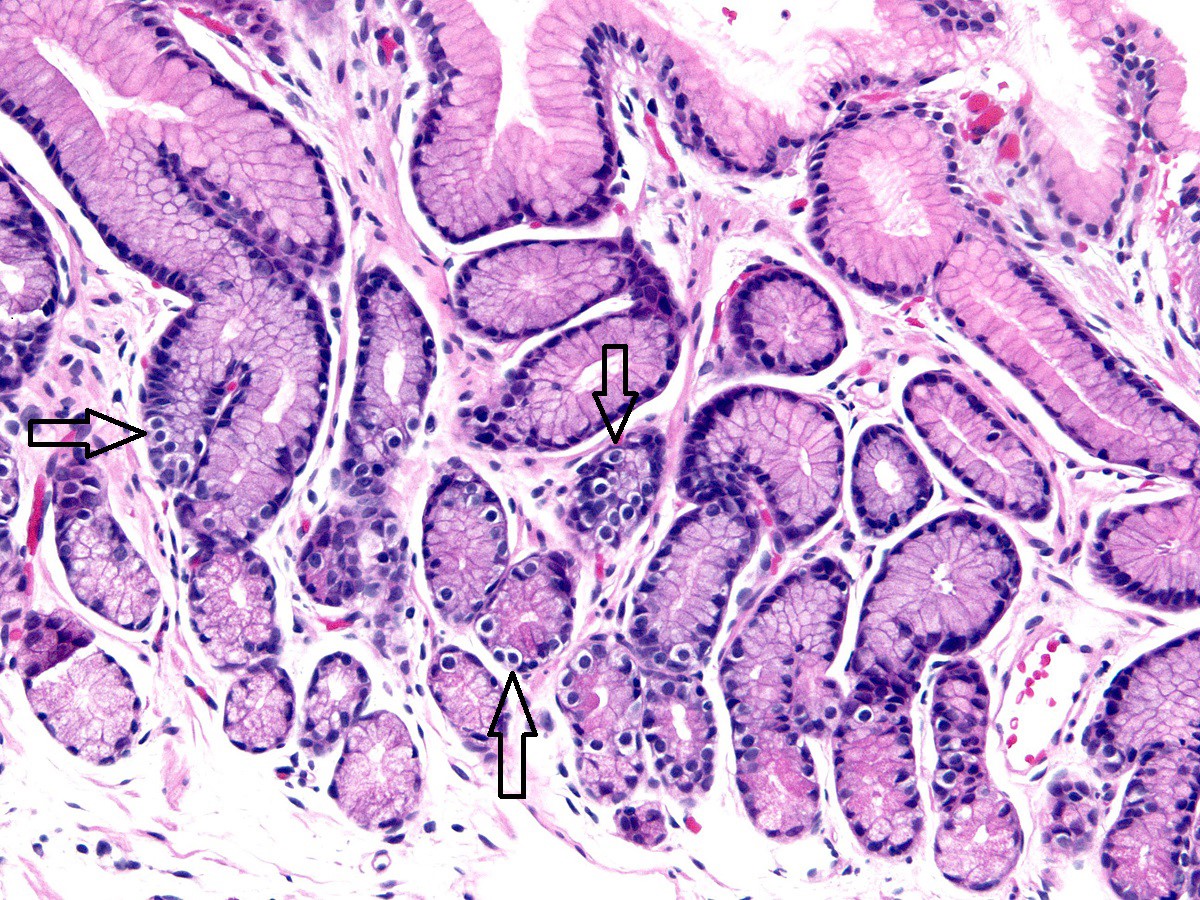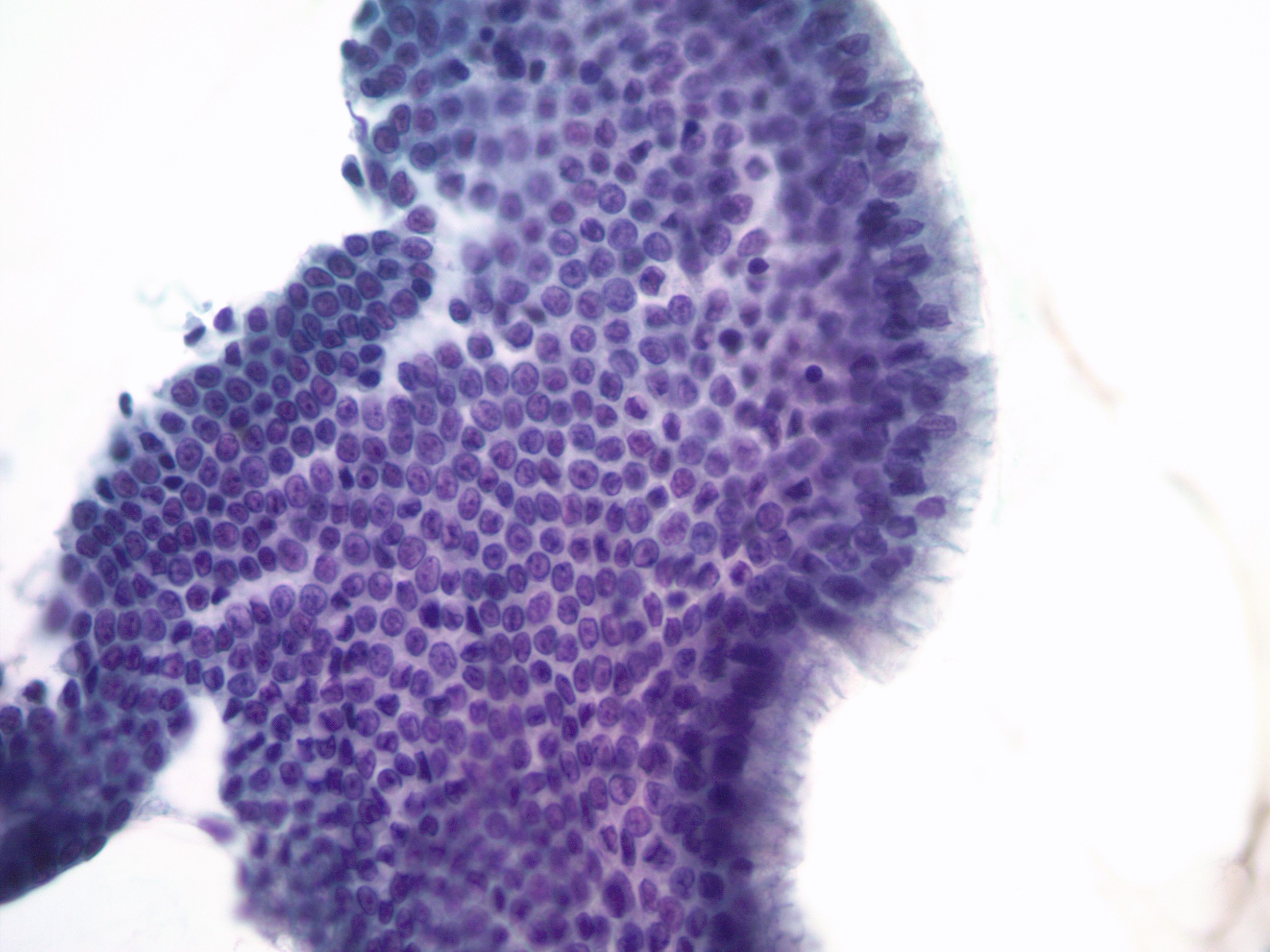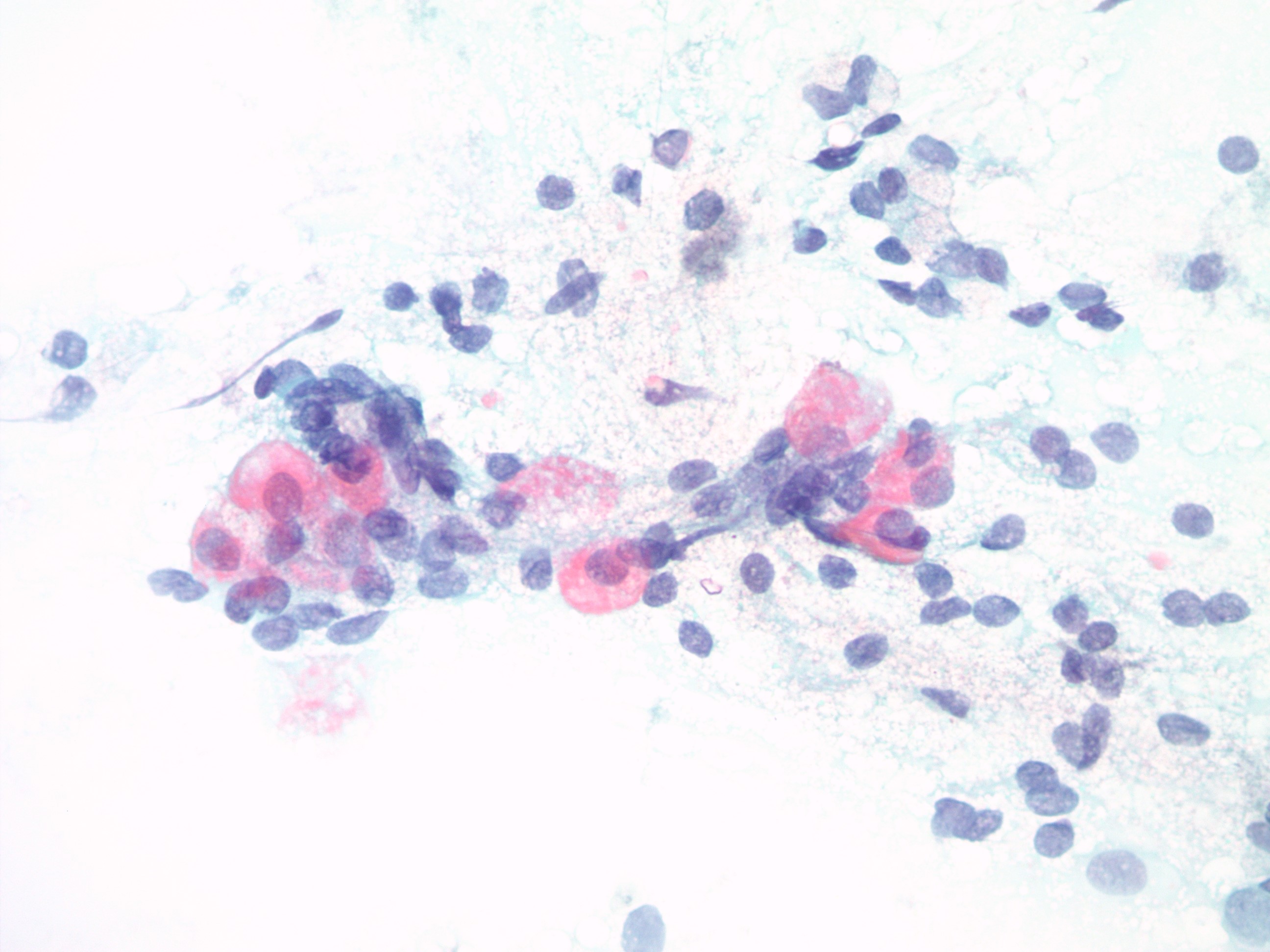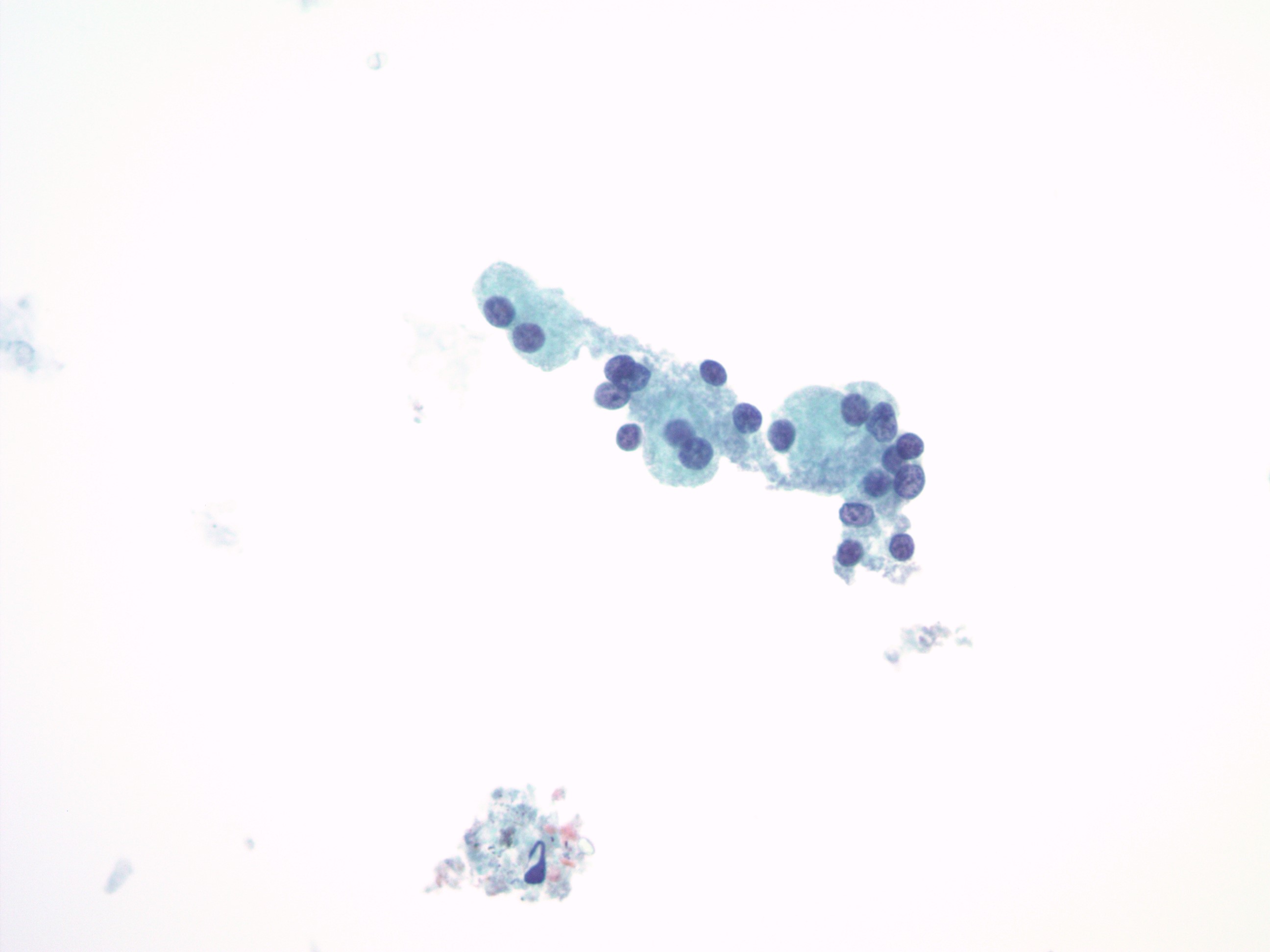Table of Contents
Definition / general | Essential features | Anatomy | Physiology | Diagrams / tables | Clinical images | Gross description | Gross images | Microscopic (histologic) description | Microscopic (histologic) images | Virtual slides | Cytology description | Cytology images | Positive stains | Sample pathology report | Additional references | Practice question #1 | Practice answer #1 | Practice question #2 | Practice answer #2 | Practice question #3 | Practice answer #3Cite this page: McHugh KE, Plesec TP. Anatomy & histology. PathologyOutlines.com website. https://www.pathologyoutlines.com/topic/stomachnormalhistology.html. Accessed September 1st, 2025.
Definition / general
- A review of the normal constituents of the gastric wall, with a focus on the gastric mucosa, its compartments, its cell types and their cellular products
Essential features
- Anatomic regions: cardia, fundus, body, antrum / pylorus
- Layers: mucosa, submucosa, muscularis propria, subserosa, serosa
- Cell types: mucous cells, parietal cells, chief cells, endocrine cells
- Cardia and antrum: mucinous glands
- Body and fundus: oxyntic glands
Anatomy
- Normal volume is 1.5 liters, capacity is 3 liters, potentially more
- Fine mosaic-like pattern of mucosa because of punctuations by gastric pits or foveolae
- Longitudinal infoldings of mucosa and submucosa known as rugae are coarser proximally and when stomach is empty
- Cardia
- Narrow conical portion distal to gastroesophageal junction
- Many authors claim that cardiac mucosa is reflux associated epithelia and not normally present
- Of note in the AJCC Cancer Staging Manual, 8th Edition (2017), carcinomas of the esophagus and the esophagogastric junction (tumor with epicenters ≤ 2 cm into cardia) are staged identically
- Fundus
- Dome shaped proximal stomach
- Body / corpus
- Remainder of stomach to incisura angularis
- Incisura angularis
- Where stomach narrows before it joins duodenum
- Antrum
- Incisura angularis to pyloric sphincter (3 - 4 cm)
- Pylorus
- Muscular ring that controls flow of food content into proximal duodenum
- Lesser curvature
- Medial curvature of stomach on the right
- Greater curvature
- Lateral curvature of stomach
Physiology
- General functions: digestion, motility, microbial defense (Statpearls: Physiology, Stomach [Accessed 28 May 2020])
- Digestive system organ that receives contents from the esophagus via the gastroesophageal sphincter and empties its contents into the duodenum via the pyloric sphincter
- Partially digests food boluses received from the esophagus
- Mechanical digestion: back and forth churning by inner oblique layer of muscularis propria
- Chemical digestion: acidic milieu breaks down proteins and kills food derived microbes
- Parietal cells secrete hydrochloric acid (HCl), which maintains acidic pH of stomach and denatures proteins
- Chief cells secrete pepsinogen, which breaks down proteins when activated to pepsin by the acidic environment
- Microenvironment of the stomach is largely regulated by enteroendocrine cell hormone secretion and vagus nerve innervation
- Empties chyme (partially digested food) into the duodenum
- Gastric emptying largely facilitated by the inner circular and outer longitudinal layers of muscularis propria
- Smooth muscle contractions (peristalsis) are controlled by the interstitial cells of Cajal (J Physiol 2006;571:1)
- Majority of nutrient absorption will occur in small bowel
- Gastric emptying largely facilitated by the inner circular and outer longitudinal layers of muscularis propria
- Partially digests food boluses received from the esophagus
Diagrams / tables
Gross description
- A malleable gastric wall with pink, smooth, glistening serosa and pink-tan velvety mucosa arranged in coarse rugal folds which are more prominent in the body and fundus, whereas antral mucosa is more flat (Am J Surg Pathol 1986;10:48)
Gross images
Microscopic (histologic) description
- Layers:
- Mucosa (with muscularis mucosae)
- Submucosa (with Meissner plexus)
- Muscularis propria (outer longitudinal layer, Auerbach / myenteric plexus, inner circular layer, innermost oblique layer)
- Subserosa
- Serosa (Am J Surg Pathol 1986;10:48)
- Anatomic regions:
- Cardia: variable length extending from 1 - 15 mm (average 5 mm) (Am J Surg Pathol 2002;26:1207)
- Loosely packed mucous secreting glands (Am J Surg Pathol 2000;24:402)
- Ratio of pit to gland volume, 50:50
- Cystic dilatation of glands and mild chronic inflammation common
- May be expanded in individuals with acid reflux (Am J Surg Pathol 2000;24:344)
- Body (corpus) and fundus: known as oxyntic mucosa
- Tightly packed glands acid and enzyme secreting glands
- Ratio of pit to gland volume, 25:75
- Parietal cells and chief cells are the glandular constituents
- Can have interspersed mucin cells, especially in glandular isthmus / neck
- Corpus antrum boundary moves proximally with age due to reduction of oxyntic mucosal volume
- Antrum / pylorus: distal 3 - 4 cm
- Loosely packed mucous secreting glands
- Ratio of pit to gland volume, 50:50
- Usually no cystic dilatation of glands
- G cells are an endocrine cell unique to this anatomic region
- Proximal extent along the lesser curvature exceeds that along the greater curvature (Gastroenterology 1972;63:584)
- Cardia: variable length extending from 1 - 15 mm (average 5 mm) (Am J Surg Pathol 2002;26:1207)
- Components of gastric mucosa:
- Gastric pits: surface invaginations that function as conduits of secretions; entirely lined by surface mucous (foveolar) cells regardless of anatomic region (Am J Surg Pathol 1986;10:48)
- Gastric glands: synthesize acids, enzymes and mucins; constituents and their products vary depending on anatomic region of the stomach
- Glands are organized into isthmus, neck and base (Am J Surg Pathol 1986;10:48)
- Gastric stem cells are housed in the isthmus and neck portion of glandular mucosa (Wiley Interdiscip Rev Dev Biol 2017;6:e261)
- Gastric cell types
- Mucous cells
- Secrete bicarbonate rich mucus that coats and lubricates the gastric surface
- Serves protective function against autodigestion
- Surface (foveolar) epithelium contains cytoplasmic neutral mucins
- Lightly eosinophilic apical mucin cap
- Mucous glands contain cytoplasmic neutral and acidic mucin (Arch Pathol 1968;85:580)
- Lightly eosinophilic to clear bubbly / vacuolated cytoplasm
- Lack an apical mucin cap
- All mucous cells have round, basally oriented nuclei
- Secrete bicarbonate rich mucus that coats and lubricates the gastric surface
- Parietal cells
- Produce hydrochloric acid via H+ / K+ -ATPase pump (Varela: Histology, Parietal Cells, 2019)
- Hydrochloric acid maintains gastric acidity (pH 1.5 to 3.5), which:
- Activates pepsinogen to active pepsin enzyme
- Kills food derived bacteria
- Facilitates food digestion
- Promotes absorption of minerals (e.g. phosphate, calcium, iron)
- Hydrochloric acid maintains gastric acidity (pH 1.5 to 3.5), which:
- Produce intrinsic factor, which is critical for vitamin B12 absorption in small bowel (Varela: Histology, Parietal Cells, 2019)
- Secretion highly regulated by extrinsic and intrinsic neuroendocrine system (Physiol Rev 2020;100:573)
- Stimulators of gastric acid secretion include:
- Vagus nerve (via acetylcholine neurotransmitter)
- Gastrin hormone
- Hypergastrinemia can be induced by glucocorticoids
- Histamine
- Grehlin
- Inhibitors of gastric acid secretion include:
- Somatostatin
- Pharmacologic agents (e.g. proton pump inhibitors)
- Stimulators of gastric acid secretion include:
- Relatively large, triangular cells with eosinophilic cytoplasm due to abundant mitochondria
- Centrally placed nuclei with evenly distributed chromatin
- Predominantly occupy the superficial half of body / fundic glands
- Produce hydrochloric acid via H+ / K+ -ATPase pump (Varela: Histology, Parietal Cells, 2019)
- Chief cells
- Produce pepsinogen I and II propeptides (Gastroenterology 1992;102:699)
- Activated to pepsin enzyme via high acidity (low pH) environment
- Cuboidal cells with basophilic to amphophilic cytoplasm due to abundant rough endoplasmic reticulum
- Predominantly occupy the basal half of corpus glands
- Produce pepsinogen I and II propeptides (Gastroenterology 1992;102:699)
- Endocrine cells
- Generally inconspicuous, round cells with clear cytoplasm
- Typically fewer than 20 endocrine cells per gland
- Cell types include: (Regul Pept 2000;93:31)
- G cells: produce gastrin
- Limited to the gastric antrum
- D cells: produce somatostatin
- Distributed throughout whole stomach
- Enterochromaffin (EC) cells: produce serotonin
- Distributed throughout whole stomach
- Enterochromaffin-like (ECL) cells: produce histamine (Int J Mol Sci 2019;20:E2444)
- Limited to the gastric body and fundus
- Secrete histamine in response to gastrin produced by G cells
- Represent 30% of all endocrine cells
- Long term gastrin stimulation causes enterochromaffin-like cell hyperplasia (e.g. in atrophic gastritis)
- X cells: produce grehlin (Int J Pept 2010;2010:945056)
- Limited to the gastric body and fundus
- G cells: produce gastrin
- Concentrated within mucous neck region in antrum / pylorus
- 50% G cells, 30% enterochromaffin cells, 15% D cells, 5% other
- Scattered throughout oxyntic glands in body and fundus
- Majority enterochromaffin-like cells; minority enterochromaffin cells, X cells, D cells
- Mucous cells
- Gastric mucosa - general:
- There are no visibly (grossly or microscopically) distinct boundaries between mucosal zones / anatomic regions (Am J Surg Pathol 1986;10:48)
- Gastric mucosa is very metabolically active
- Gastric surface epithelium is normally replaced every 4 - 8 days (Gastroenterology 1977;72:962)
- Gastric parietal and chief cells turn over more slowly: every 1 - 3 years (J Natl Cancer Inst 1969;42:9)
- Undifferentiated stem cells are concentrated in the isthmus / neck of gastric glands throughout the entire stomach
- Lamina propria provides structural support (Am J Surg Pathol 1986;10:48)
- Structural components: reticulin, collagen and elastin fibers; capillaries and arterioles; nerve fibers; few smooth muscle fibers
- Cell types: fibroblasts, histiocytes, plasma cells, lymphocytes; occasional mast cells and eosinophils
- Lymphoid tissue is sparse in lamina propria (Hum Pathol 1993;24:577)
- Superficial lamina propria with small numbers of lymphocytes (B cells > T cells) and plasma cells
- Can see small lymphoid aggregates (no germinal centers) in gastric antrum immediately superficial to muscularis mucosae
- Intraepithelial lymphocytes absent or sparse
- Lymphatic channels are present within gastric mucosa, generally immediately superficial to muscularis mucosae
- Gastric mucosa protects itself against autodigestion / high acidity (Physiol Rev 1993;73:823)
- Mucus secretion: mucus is relatively impermeable to H+; also fluid with acid or pepsin exits gastric glands as jets and penetrates surface mucus layer without contacting surface epithelial cells (Am J Physiol Gastrointest Liver Physiol 2017;313:G599)
- Bicarbonate secretion creates pH neutral microenvironment adjacent to cell surface
- Intercellular tight junctions prevent back diffusion of H+ and disruptions are quickly repaired
- Rich blood flow supplies bicarbonate and nutrients and removes acid
- Muscularis mucosae limits injury; if intact, mucosal repair occurs in hours / days versus weeks if not intact
Microscopic (histologic) images
Cytology description
- Mucous cells: tightly cohesive columnar cells with basal round to ovoid nuclei in orderly, honeycombed sheets
- Usually the predominant cell type
- Chief cells: small cuboidal cells with round, smooth nuclei, fine nuclear chromatin and basophilic cytoplasmic granules in honeycombed sheets
- Comparable in appearance to pancreatic or salivary acinar cells
- Parietal cells: pyramidal to flask shaped cells with round nuclei, coarse nuclear chromatin and abundant intensely eosinophilic cytoplasm
- Larger than chief cells
Cytology images
Positive stains
- Mucous cells: PAS (Indian J Med Paediatr Oncol 2013;34:229)
- Endocrine cells / enterochromaffin-like cells: chromogranin, synaptophysin, CD56, INSM1 (Am J Clin Pathol 2020;153:811)
- G cells: gastrin (J Cancer Res Clin Oncol 2006;132:85)
Sample pathology report
- Stomach, cardia, biopsy:
- Gastric cardia mucosa with no significant diagnostic alteration
- No evidence of Helicobacter pylori microorganisms
- Stomach, body / fundus, biopsy:
- Gastric oxyntic mucosa with no significant diagnostic alteration
- No evidence of Helicobacter pylori microorganisms
- Stomach, antrum, biopsy:
- Gastric antral mucosa with no significant diagnostic alteration
- No evidence of Helicobacter pylori microorganisms
Additional references
Practice question #1
Practice answer #1
Practice question #2
- The Meissner plexus is located within which layer of the stomach?
- Mucosa
- Muscularis propria
- Serosa
- Submucosa
- Subserosa
Practice answer #2
Practice question #3
- Which of the following ratios most accurately described the gastric pit to gastric gland ratio within the corpus (body / fundus) of the stomach?
- 10:90
- 25:75
- 50:50
- 75:25
- 90:10
Practice answer #3



